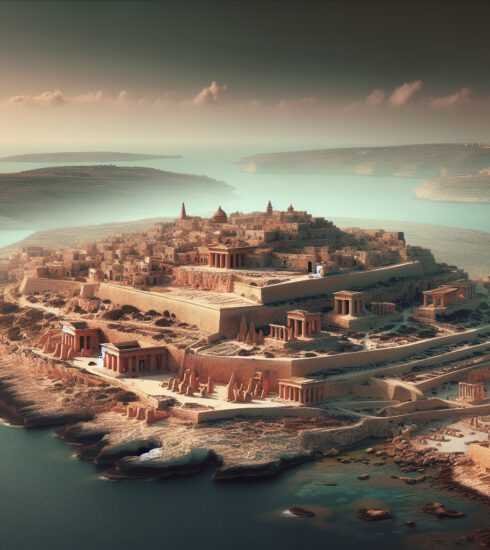Unveiling Maltas Megalithic Marvels: Discover the Enigmatic Secrets of Ancient Temples
Unlocking the Mysteries of Malta’s Megalithic Temples
Introduction
Malta, a small island nation located in the Mediterranean Sea, is home to some of the most fascinating historical sites in the world. Among these sites are the megalithic temples, which date back thousands of years and provide insight into the lives of ancient civilizations. These temples, built with enormous stone blocks, offer a glimpse into the religious and cultural practices of the people who lived on the island during prehistoric times. This article aims to delve into the mysteries of Malta’s megalithic temples, exploring their significance, architectural marvel, and the ongoing research to understand their purpose.
The Significance of Malta’s Megalithic Temples
The megalithic temples of Malta, also known as Ġgantija temples, are considered to be one of the oldest freestanding structures in the world. They were constructed during the Neolithic era, between 3600 and 2500 BCE, predating other famous ancient structures such as Stonehenge and the Egyptian pyramids. This makes them a significant archaeological find and a UNESCO World Heritage Site.
The temples were used for sacred rituals, ceremonies, and religious practices by the early inhabitants of Malta. These structures provide important insights into the religious beliefs and practices of these ancient civilizations. The temples are believed to have been centers of worship and served as gathering places for the community.
The Architecture of Malta’s Megalithic Temples
Malta’s megalithic temples are characterized by their impressive architecture and construction. They were built using enormous stone blocks, some of which weigh over 50 tons. The temples consist of multiple chambers and corridors, with intricate carvings and decorations adorning the walls. The precision with which these temples were constructed is extraordinary, given the limited tools and technology available during that time.
The temples are typically constructed in a cloverleaf shape, with three or more apses branching off from a central space. The stone blocks used in their construction were cut and shaped with great precision, with some of the stones fitting together so tightly that not even a sheet of paper could be inserted between them.

Malta’s Megalithic Temples: A Testimony to Human Ingenuity
The construction of Malta’s megalithic temples is a testament to the incredible engineering skills and craftsmanship of the ancient civilizations that inhabited the island. The sheer size of the stones used in their construction and the precision with which they were placed together is a marvel in itself.
The methods used to transport these massive stones to the construction sites remain a mystery. It is believed that primitive sledges, ropes, and ramps might have been used to move the stones from their quarry to the temples. However, the exact techniques employed by the ancient people of Malta are still subject to speculation and ongoing research.
The Purpose and Function of Malta’s Megalithic Temples
While much is known about the architectural prowess of the ancient builders, the purpose and function of Malta’s megalithic temples remain somewhat elusive. Archaeologists and historians have put forward several theories to explain the role of these structures in the ancient society. Some of the popular hypotheses include:
- Religious and Ritualistic Purposes: Many experts believe that the temples were primarily used for religious rituals and ceremonies. They served as sacred spaces for the community to worship their deities and perform rituals related to fertility, harvest, and other important aspects of their lives.
- Community Spaces: Another theory suggests that the temples served as community gathering places where people would come together to socialize, trade, and engage in communal activities. The large central spaces within the temples could accommodate a significant number of people, making them suitable for such purposes.
- Burial Sites: Some temples have shown evidence of human remains, leading to the theory that they might have functioned as burial sites. These temples would have held great significance for the community as they served as a final resting place for their loved ones.
While these theories provide plausible explanations, the true purpose of Malta’s megalithic temples remains a subject of ongoing research and debate.
The Hypogeum of Ħal-Saflieni: An Intriguing Subterranean Temple
Aside from the above-ground megalithic temples, Malta is also home to an impressive subterranean temple known as the Hypogeum of Ħal-Saflieni. This unique structure, carved into the limestone bedrock, was discovered in 1902 and is believed to date back to around 3600 BCE. It is considered one of the most important prehistoric sites in the world.

The Hypogeum consists of a series of interconnected chambers spread over three levels. It served multiple purposes, including burial, religious rituals, and possibly as a place of oracles or healing. The walls of the chambers are adorned with fascinating carvings and paintings, further adding to the mysterious nature of the site.
Visiting the Hypogeum is an unforgettable experience. Due to its delicate condition, only a limited number of visitors are allowed each day, and advance booking is necessary. This ensures the preservation of the site while also offering an opportunity for visitors to witness the ancient marvel firsthand.
Ongoing Research and Preservation Efforts
The megalithic temples of Malta continue to captivate archaeologists, historians, and researchers alike. Ongoing studies and excavations are shedding new light on the history and purpose of these ancient structures. Advanced techniques such as radiocarbon dating, 3D imaging, and archaeological surveys have contributed to a deeper understanding of their construction methods and historical context.
Preservation efforts are also a significant aspect of the ongoing work surrounding Malta’s megalithic temples. These structures, though built to last, are subject to the effects of time, weathering, and human activity. Various organizations, including the Maltese government and UNESCO, are committed to protecting and conserving these ancient treasures for future generations to appreciate.
One of the most notable preservation projects is the restoration of the Ġgantija temples on the island of Gozo. These temples had suffered significant damage over the centuries, and in an effort to preserve their structural integrity and prevent further deterioration, restoration work was undertaken. The project aimed to stabilize the temples and ensure their long-term preservation, allowing visitors to continue experiencing their magnificence.
In Conclusion
Malta’s megalithic temples are a testament to the ingenuity and cultural richness of the ancient civilizations that once thrived on the island. These structures offer a window into the past, allowing us to gain insight into the religious beliefs, architectural skills, and communal practices of the people who called Malta their home thousands of years ago.
While many questions surrounding the purpose and function of these temples remain unanswered, ongoing research and preservation efforts are continually uncovering new information and ensuring that these ancient landmarks are protected for future generations. Visiting these megalithic temples and exploring their mysteries is truly a fascinating journey back in time.
To learn more about Malta’s megalithic temples, visit https://en.wikipedia.org/wiki/%C4%A0gantija.






